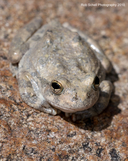|
Description
Hyla arenicolor adult frogs range from 32-57 mm in SVL. It has rough warty skin which prevents desiccation. Webbing is well developed but does not extend to the hind leg's fifth toe. Toe pads are considerably enlarged. It is distinguished from similar species by having a dark-edged light spot beneath the eye, instead of a dark bar running through the eye. Dorsal coloration is brown to gray and randomly spotted, while ventral coloration is cream to orange-yellow. This coloration aids in its ability to camouflage. When exposed to sun, the dorsal coloration changes from being normally dark to a light gray. (Stebbins 2003). Hyla arenicolor feeds on a variety of insects, including beetles, ants, and caterpillers (Behler 1979). Distribution and Habitat
Country distribution from AmphibiaWeb's database: Mexico, United States U.S. state distribution from AmphibiaWeb's database: Arizona, Colorado, New Mexico, Nevada, Texas, Utah
Specifically found in parts of southern and western Colorado. Isolated populations found in northeastern New Mexico and certain regions of Texas (Behler 1979). Habitat ranges from arid environments to streambanks. Most often found in pools at the bottoms of canyons. It generally lives on the ground but can be found in trees and clinging to boulders (Stebbins 2003). Life History, Abundance, Activity, and Special Behaviors
Breeding period ranges from March to July but can be extended due to insufficient rainfall. (Stebbins 2003). Vocal calls are hollow, nasal, and explosive, lasting only 1-3 seconds (Behler 1979). Trends and Threats
Overcollection from humans. It is vulnerable due to exposure while basking on rocks (Stebbins 2003). Relation to Humans
Have been used in experiments to test the thermoregulation relating to how its skin manages water uptake (Snyder and Hammerson 1992). Possible reasons for amphibian decline Intentional mortality (over-harvesting, pet trade or collecting)
Comments
Albinos have been found only in this species of Hyla. In albino frogs, the eyes have red pupils with white irises (Van Devender 1969).
References
Barber, P. H. (1999). ''Phylogeography of the Canyon Treefrog, Hyla arenicolor (Cope) based on mitochondrial DNA sequence data.'' Molecular Ecology, 8(4), 547.
Behler, J. L. (1979). The Audubon Society Field Guide to North American Reptiles and Amphibians. Alfred A. Knopf, Inc., New York.
Snyder, G. K. Hammerson, G. A. (1992). ''Interrelationships between water economy and thermoregulation in the Canyon Tree-frog Hyla arenicolor.'' Journal of Arid Environments, 1993(25), 321-329.
Stebbins, R. C. (2003). Western Reptiles and Amphibians, Third Edition. Houghton Mifflin, Boston.
Van Devender, T. R. (1969). ''A record of albinism in the Canyon Tree Frog, Hyla arenicolor Cope.'' Herpetologica, 25(1), 69.
Originally submitted by: Michelle Iwaki (first posted 2001-05-09)
Edited by: Kellie Whittaker (2007-12-14)Species Account Citation: AmphibiaWeb 2007 Hyla arenicolor: Canyon Treefrog <https://amphibiaweb.org/species/720> University of California, Berkeley, CA, USA. Accessed Apr 26, 2024.
Feedback or comments about this page.
Citation: AmphibiaWeb. 2024. <https://amphibiaweb.org> University of California, Berkeley, CA, USA. Accessed 26 Apr 2024.
AmphibiaWeb's policy on data use.
| 





 Map of Life
Map of Life